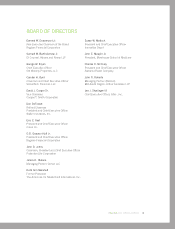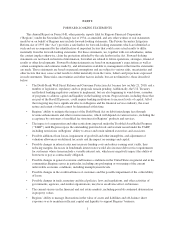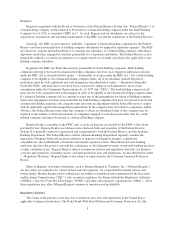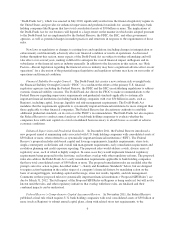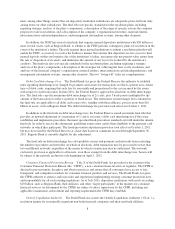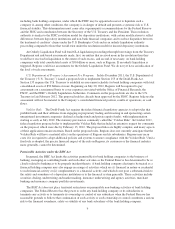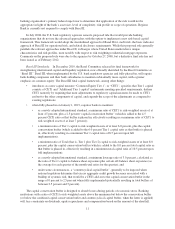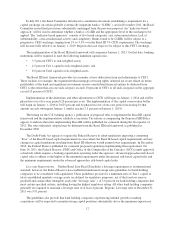Regions Bank 2011 Annual Report Download - page 30
Download and view the complete annual report
Please find page 30 of the 2011 Regions Bank annual report below. You can navigate through the pages in the report by either clicking on the pages listed below, or by using the keyword search tool below to find specific information within the annual report.“Dodd-Frank Act”), which was enacted in July 2010, significantly restructures the financial regulatory regime in
the United States and provides for enhanced supervision and prudential standards for, among other things, bank
holding companies like Regions that have total consolidated assets of $50 billion or more. The implications of
the Dodd-Frank Act for our business will depend to a large extent on the manner in which rules adopted pursuant
to the Dodd-Frank Act are implemented by the Federal Reserve, the FDIC, the SEC, and other government
agencies, as well as potential changes in market practices and structures in response to the requirements of those
rules.
New laws or regulations or changes to existing laws and regulations (including changes in interpretation or
enforcement) could materially adversely affect our financial condition or results of operations. As discussed
further throughout this section, many aspects of the Dodd-Frank Act are subject to further rulemaking and will
take effect over several years, making it difficult to anticipate the overall financial impact on Regions and its
subsidiaries or the financial services industry generally. In addition to the discussion in this section, see “Risk
Factors—Recent legislation regarding the financial services industry may have a significant adverse effect on our
operations” for a discussion of the potential impact legislative and regulatory reforms may have on our results of
operations and financial condition.
Financial Stability Oversight Council. The Dodd-Frank Act creates a new systemic risk oversight body,
the Financial Stability Oversight Council (“FSOC”) to coordinate the efforts of the primary U.S. financial
regulatory agencies (including the Federal Reserve, the FDIC and the SEC) in establishing regulations to address
systemic financial stability concerns. The Dodd-Frank Act directs the FSOC to make recommendations to the
Federal Reserve regarding supervisory requirements and prudential standards applicable to systemically
important financial institutions (including bank holding companies with over $50 billion in assets, such as
Regions), including capital, leverage, liquidity and risk-management requirements. The Dodd-Frank Act
mandates that the requirements applicable to systemically important financial institutions be more stringent than
those applicable to other financial companies. The Federal Reserve has discretionary authority to establish
additional prudential standards, on its own or at the FSOC’s recommendation. The Dodd-Frank Act also requires
the Federal Reserve to conduct annual analyses of such bank holding companies to evaluate whether the
companies have sufficient capital on a total consolidated basis necessary to absorb losses as a result of adverse
economic conditions.
Enhanced Supervision and Prudential Standards. In December 2011, the Federal Reserve introduced a
new proposal aimed at minimizing risks associated with U.S. bank holding companies with consolidated assets of
$50 billion or more, often referred to as systemically important financial institutions (“SIFI”). The Federal
Reserve’s proposal includes risk-based capital and leverage requirements, liquidity requirements, stress tests,
single-counterparty credit limits and overall risk management requirements, early remediation requirements and
resolution planning and credit exposure reporting. The proposed rules would address a wide, diverse array of
regulatory areas, each of which is highly complex. In some cases they would implement financial regulatory
requirements being proposed for the first time, and in others overlap with other regulatory reforms. The proposed
rules also address the Dodd-Frank Act’s early remediation requirements applicable to bank holding companies
that have total consolidated assets of $50 billion or more. The proposed remediation rules are modeled after the
prompt corrective action regime, described under “—Safety and Soundness Standards” below, but are designed
to require action beginning in the earlier stages of a company’s financial distress by mandating action on the
basis of arranged triggers, including capital and leverage, stress test results, liquidity, and risk management.
Comments on these proposed rules for systemically important financial institutions (“Proposed SIFI Rules”) are
due by March 31, 2012. The full impact of the Proposed SIFI Rules on Regions is being analyzed, but will not be
known until the rules, and other regulatory initiatives that overlap with these rules, are finalized and their
combined impacts can be understood.
Federal Reserve’s Comprehensive Capital Assessment Review. In November 2011, the Federal Reserve
published a final rule which requires U.S. bank holding companies with total consolidated assets of $50 billion or
more (such as Regions) to submit annual capital plans, along with related stress test requirements, to the
6



